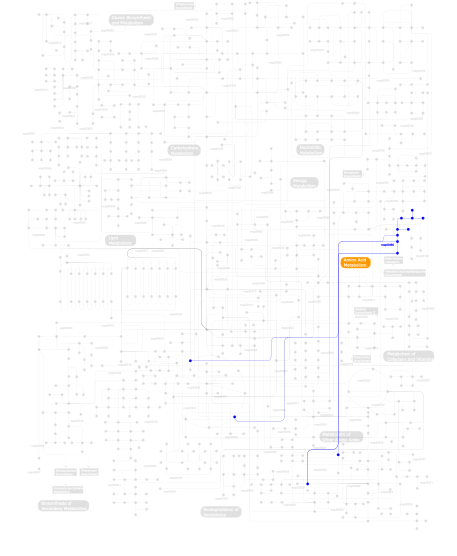The domain within your query sequence starts at position 1775 and ends at position 1823; the E-value for the ZnF_ZZ domain shown below is 2.54e-7.
LNVDISCDGCDEIAPWHRYRCLQCSDMDLCKTCFLGGVKPEGHGDDHEM
ZnF_ZZZinc-binding domain, present in Dystrophin, CREB-binding protein. |
|---|
| SMART accession number: | SM00291 |
|---|---|
| Description: | Putative zinc-binding domain present in dystrophin-like proteins, and CREB-binding protein/p300 homologues. The ZZ in dystrophin appears to bind calmodulin. A missense mutation of one of the conserved cysteines in dystrophin results in a patient with Duchenne muscular dystrophy [3]. |
| Interpro abstract (IPR000433): | Zinc finger (Znf) domains are relatively small protein motifs which contain multiple finger-like protrusions that make tandem contacts with their target molecule. Some of these domains bind zinc, but many do not; instead binding other metals such as iron, or no metal at all. For example, some family members form salt bridges to stabilise the finger-like folds. They were first identified as a DNA-binding motif in transcription factor TFIIIA from Xenopus laevis (African clawed frog), however they are now recognised to bind DNA, RNA, protein and/or lipid substrates [ (PUBMED:10529348) (PUBMED:15963892) (PUBMED:15718139) (PUBMED:17210253) (PUBMED:12665246) ]. Their binding properties depend on the amino acid sequence of the finger domains and of the linker between fingers, as well as on the higher-order structures and the number of fingers. Znf domains are often found in clusters, where fingers can have different binding specificities. There are many superfamilies of Znf motifs, varying in both sequence and structure. They display considerable versatility in binding modes, even between members of the same class (e.g. some bind DNA, others protein), suggesting that Znf motifs are stable scaffolds that have evolved specialised functions. For example, Znf-containing proteins function in gene transcription, translation, mRNA trafficking, cytoskeleton organisation, epithelial development, cell adhesion, protein folding, chromatin remodelling and zinc sensing, to name but a few [ (PUBMED:11179890) ]. Zinc-binding motifs are stable structures, and they rarely undergo conformational changes upon binding their target. This entry represents ZZ-type zinc finger domains, named because of their ability to bind two zinc ions [ (PUBMED:8848831) ]. These domains contain 4-6 Cys residues that participate in zinc binding (plus additional Ser/His residues), including a Cys-X2-Cys motif found in other zinc finger domains. These zinc fingers are thought to be involved in protein-protein interactions. The structure of the ZZ domain shows that it belongs to the family of cross-brace zinc finger motifs that include the PHD, RING, and FYVE domains [ (PUBMED:15476823) ]. ZZ-type zinc finger domains are found in:
Single copies of the ZZ zinc finger occur in the transcriptional adaptor/coactivator proteins P300, in cAMP response element-binding protein (CREB)-binding protein (CBP) and ADA2. CBP provides several binding sites for transcriptional coactivators. The site of interaction with the tumour suppressor protein p53 and the oncoprotein E1A with CBP/P300 is a Cys-rich region that incorporates two zinc-binding motifs: ZZ-type and TAZ2-type. The ZZ-type zinc finger of CBP contains two twisted anti-parallel beta-sheets and a short alpha-helix, and binds two zinc ions [ (PUBMED:15476823) ]. One zinc ion is coordinated by four cysteine residues via 2 Cys-X2-Cys motifs, and the third zinc ion via a third Cys-X-Cys motif and a His-X-His motif. The first zinc cluster is strictly conserved, whereas the second zinc cluster displays variability in the position of the two His residues. In Arabidopsis thaliana (Mouse-ear cress), the hypersensitive to red and blue 1 (Hrb1) protein, which regulating both red and blue light responses, contains a ZZ-type zinc finger domain [ (PUBMED:15705950) ]. ZZ-type zinc finger domains have also been identified in the testis-specific E3 ubiquitin ligase MEX that promotes death receptor-induced apoptosis [ (PUBMED:16522193) ]. MEX has four putative zinc finger domains: one ZZ-type, one SWIM-type and two RING-type. The region containing the ZZ-type and RING-type zinc fingers is required for interaction with UbcH5a and MEX self-association, whereas the SWIM domain was critical for MEX ubiquitination. In addition, the Cys-rich domains of dystrophin, utrophin and an 87kDa post-synaptic protein contain a ZZ-type zinc finger with high sequence identity to P300/CBP ZZ-type zinc fingers. In dystrophin and utrophin, the ZZ-type zinc finger lies between a WW domain (flanked by and EF hand) and the C-terminal coiled-coil domain. Dystrophin is thought to act as a link between the actin cytoskeleton and the extracellular matrix, and perturbations of the dystrophin-associated complex, for example, between dystrophin and the transmembrane glycoprotein beta-dystroglycan, may lead to muscular dystrophy. Dystrophin and its autosomal homologue utrophin interact with beta-dystroglycan via their C-terminal regions, which are comprised of a WW domain, an EF hand domain and a ZZ-type zinc finger domain [ (PUBMED:17009962) ]. The WW domain is the primary site of interaction between dystrophin or utrophin and dystroglycan, while the EF hand and ZZ-type zinc finger domains stabilise and strengthen this interaction. |
| GO function: | zinc ion binding (GO:0008270) |
| Family alignment: |
There are 21616 ZnF_ZZ domains in 18218 proteins in SMART's nrdb database.
Click on the following links for more information.
- Evolution (species in which this domain is found)
- Metabolism (metabolic pathways involving proteins which contain this domain)
- Structure (3D structures containing this domain)
- Links (links to other resources describing this domain)











